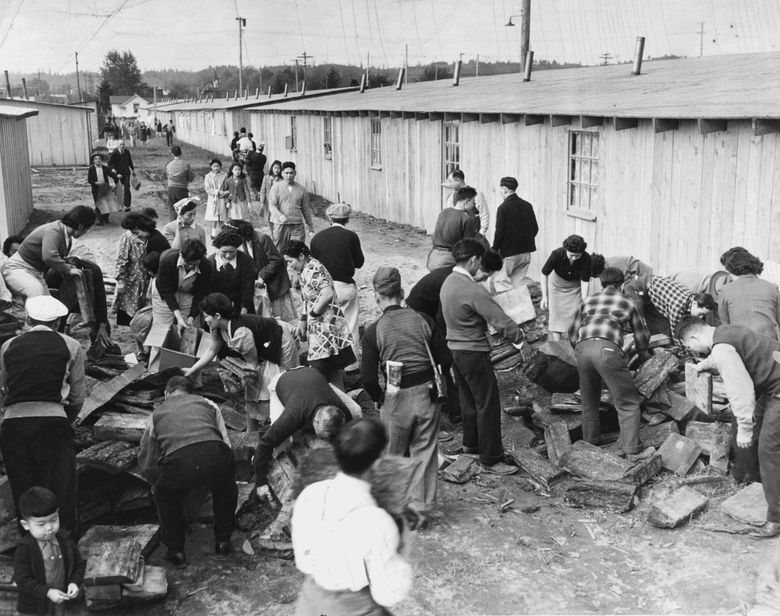In 1942, the site of the Washington State Fair was chosen as a temporary incarceration camp for Japanese Americans while a permanent camp was being built in southern Idaho. Around 1,000 laborers constructed facilities to house over 7,000 people in 30 days. Work started at the 40-acre parking lot, or Area A. Barracks were crammed in every possible place, including on the racetrack and under the grandstands.
For Issei (Japan-born emigrants) and Nisei (children of Japanese emigrants) who were imprisoned there, the crude facilities, lack of privacy and dehumanizing conditions were their first shocking experiences of American wartime incarceration.
There were no cameras allowed at the camps. The few photographs printed in newspapers at the time showed smiling families. An army public relations officer gave the prison the euphemism “Camp Harmony.” It was anything but harmonious.
After the Minidoka incarceration camp opened in Idaho on August 10, 1942, those imprisoned at the Puyallup fairgrounds were transported to Minidoka by train for three more years of imprisonment.
“The fairgrounds were divided into four areas, the three large parking lots and the main fair complex. Each area was enclosed with barbed wire. Each area had two guard towers with machine guns pointing at us,” remembered Cho Shimizu, who was only 5 years old at the time he and his family were incarcerated.
Writing for The New Republic in 1942, Ted Nakashima wrote, “The resettlement center is actually a penitentiary — armed guards in towers with spotlights and deadly tommy guns, fifteen feet of barbed-wire fences, everyone confined to quarters at nine, lights out at ten o’clock. The guards are ordered to shoot anyone who approaches within twenty feet of the fences. No one is allowed to take the two-block-long hike to the latrines after nine, under any circumstances.”
Moving between camps was only possible by special escort. When it rained, open areas between barracks would turn to mud.
Each camp had common mess halls, laundry and sanitation facilities. Shimizu remembered how some Puyallup residents tried to help them. Students or teachers from nearby schools would throw sports equipment and toys over the fence to children because they didn’t have anything to play with.
Area A included six 40-by-100-foot mess halls, permitting 500 people at a single feeding. “Our food was rations and canned foods, nothing fresh,” said Shimizu.
According to an American Red Cross survey at the time, 50 cents was the army allowance of cost per ration for each person per day.
Area D included the “bachelor’s barracks,” the racetrack and administrative offices, as well as a 100-bed hospital. At one point, Shimizu contracted measles, so he and his entire family were moved to the isolation ward under the grandstands where those with tuberculosis were quarantined.
The barracks
Barracks were called rabbit hutches in reports at the time. Entire families were crowded into one room, with one cot per person. The walls didn’t extend all the way up to the ceiling, leaving a gap of up to 4 feet, so everything could be heard between rooms. “The building itself was haphazard, with leaky roofs, no foundations and open walls at the top,” Shimizu said. “We were crowded into one 20-by-20-foot room. There were ten of us all together! We had a single light bulb and a potbelly stove. No running water!”
Some prisoners would find or salvage scrap wood and craft tables or other structures in the barracks. When Mary Abo’s older brother brought home some scrap wood, their mother “became hysterical because she thought he would be jailed for stealing,” Abo said.
Latrines and showers
“Our sanitation facilities were community facilities where we all shared the same showers and bathrooms like cattle at the fairgrounds. There was no privacy,” Shimizu remembered. “The showers had a pipe with holes which sprayed water down on people … no on/off knobs, no temperature control, no privacy curtain.” Some people would postpone showering for as long as they could out of modesty.
The latrines were even worse. “I think of my mother having to use the latrine,” Shimizu remembered. “There were no individual stalls, just two 12-by-20-[foot] planks of wood with holes. My mother was a very humble and proud Issei, and to sit side-by-side, back-to-back, must have been humiliating.”
Beneath the wooden holes was a large pan that would be flushed with water every so often.
Timeline
1941
- December 7: Japan attacks Pearl Harbor.
1942
- February 19: President Roosevelt signs Executive Order 9066, authorizing the Secretary of War to designate areas on the West Coast as zones of exclusion.
- March 30: Bainbridge Island’s 250 Japanese American residents were taken by ferry to Seattle, then by train to Manzanar, a prison in Southern California.
- April: Construction at Puyallup fairgrounds begins.
- April 28: The first Japanese Americans are imprisoned at Puyallup.
- August 12: The start of general transportation to Minidoka.
- September 12: The last train deporting prisoners leaves for Minidoka.
- September 30: The Puyallup fairgrounds are taken over by Fort Lewis Ninth Service Command, and is repurposed as an army training center until the end of the war.
1945
- September 2: War ends.
- October 28: Minidoka closes.
1946
- Washington State Fair reopens.
Sources: Densho Encyclopedia; History Link; University of Washington Special Collections.

The opinions expressed in reader comments are those of the author only and do not reflect the opinions of The Seattle Times.